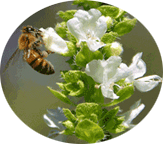Why Cooked Foods are Healthier
© Copyright Bee Wilder, Revised March 19, 2011
There are many “Raw Foodists” today who claim that raw plant foods, meats and eggs are more healthy than cooked foods. Raw foodism (or rawism) is a lifestyle promoting the consumption of un-cooked, un-processed, and often organic foods as a large percentage of the diet. If 75% or more of a person’s total food consumption is raw food, he/she is considered a raw foodist or living foodist.
Raw foodists typically believe that the greater the percentage of raw food in the diet, the greater the health benefits. Raw foodism or a raw diet is usually equated with raw veganism in which only raw plant foods are eaten, but other raw foodists emphasize raw meat and other raw animal products – Raw foodism. For example The Primal Diet.
All–raw folks also claim Dr. Weston A. Price as their source of information. Yet, Price never advocated an all–raw diet. He described the use of cooked foods in every culture he visited and specifically recommended that grains and most vegetables be cooked. His advice to his nieces and nephews: "The cooked vegetables are better since raw vegetables are usually too bulky to allow very much mineral to be obtained from them." He never recommended raw vegetable juices, and most certainly not as a major part of the diet.
. . . cooking makes the minerals [and nutrients] in most vegetables more available, so they should be cooked—and then eaten with a source of [mineral] activators, such as butter or cream. Bones yield their minerals by cooking into broth. And studies carried out subsequent to Dr. Price’s research reveal that grains and legumes must be soaked or sour leavened to neutralize mineral–blocking phytic acid."
The Primal Diet Claims that Cooking Destroys Nutrients, and Alters Fats & Proteins
Aajonus Vonderplanitz writes in his book “The Primal Diet”: "Cooking destroys enzymes and vitamins, alters fats and proteins into toxic substances, such as, lipid [fat] oxides. Lipid oxides and other toxins that result from cooking food are disease producing and carcinogenic [cancer–causing substances]. But that is not true!
However, enzymes and nutrients in plant foods are encased inside cellulose cell walls (fibers), that are not available to humans since we do not have digestive enzymes that break down cellulose. Cooking and fermenting plant foods (includes vegetables, fruits, herbs, spices, sugars, etc.) breaks down cell walls releasing the nutrients and enzymes locked inside them.
Of course meats should not be overcooked, or cooked using high heat, because more moisture is lost and the protein molecules bind closer together making it more difficult for stomach acid and other enzymes to break them apart.
Cooking actually makes meats more digestible because it starts the denaturing process, meaning it starts breaking or splitting apart protein molecules. Digestion also denatures protein, i.e. stomach acid denatures protein and so do pancreatic and intestinal enzymes. Therefore eating raw meats or eggs does not aid digestion, so they should be cooked to medium over low heat.
It is also not true that cooking alters fats into toxic substances. Fats are only altered if they are cooked on high heat to the point of burning. “Good” fats like unrefined coconut oil and lard can withstand fairly high heat without being damaged as this reference states: “Coconut oil is not easily damaged by heat. (It has a smoking point of 177°C or 350°F. No cooking oil should be heated above its smoking point.) Unrefined virgin coconut oil does not readily oxidise like unsaturated oils [vegetable, grains, nut and seeds oils] do when heated, leading to free-radical formation.
Dr. Weston A. Price studied the Eskimos in the 1930s and he found they did not have degenerative diseases or dental decay, see Chapters 1-21 of Dr. Price’s book is available online: Nutrition and Physical Degeneration, however it is missing Chapters 22-28.
It is not true that Eskimos ate 99% of their food raw. Vilhjalmur Stefansson, an anthropologist and Canadian explorer who lived with the Eskimos for 5 years wrote that Eskimos only ate raw meat “if” they were not in a position to be able to cook them and that they actually preferred cooked meats. Here’s a quote from V. Stefansson’s book Fat of the Land, pages 104-05:
“It was not true, as implied by the usual northern movie and by some writers, that Eskimos preferred to eat their food raw. A few things were preferred raw, among them seal liver; but most were preferred boiled or roasted, and if they were eaten raw it was usually for convenience.”
Aajonus also writes that meats can be soaked in an acid medium, i.e. chicken in lemon juice, and he thinks they are still raw, but they are not raw. Soaking meats in any kind of acid medium is another way to cook foods, which denatures them and makes them more digestible. That is why marinading meats makes them more tender. An example of meats cooked in an acid medium is called Ceviche, which is fish or seafoods "cooked in" lemon or lime juice.
Acidic Mediums
- lemon, lime, grapefruit, and tomato juice
- whey (a thin, clear liquid that separates from natural yogurt and cheese); see Whey Recipe.
- raw apple cider vinegar, unfiltered and unpasteurized, i.e. Eden’s or Bragg’s
- buttermilk
